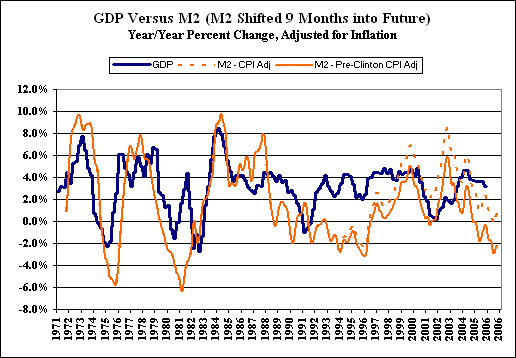Money Supply M2 as a Leading Economic Indicator
Reporting Focus from the March 2006 Edition of the SGS Newsletter
The Federal Reserve will cease reporting Money Supply M3 on March 23rd. At that time, M2 will become the broadest monetary aggregate published by the Federal Reserve.
As to M3, we have been looking at ways to estimate or model the components that will cease to be published, so that an M3 estimate could be published on at least a monthly basis. While efforts continue, the prospects for a meaningful M3 replacement do not look promising. This circumstance will be discussed in the April newsletter’s money supply section.
While it is not as strong an indicator as M3, particularly as to indicating monetary inflation pressures, M2 does generate reasonably good signals of pending recessions, enough so as to be used as one of the traditional leading economic indicators. It is the relationship between M2 and GDP growth that is explored this month.
The historical relationship between M2 and GDP growth rates can be seen in the following graphs. Shown is the three-month moving average of year-to-year growth in real (inflation-adjusted) M2, plotted against year-to-year growth in quarterly, real GDP.


In both graphs, M2 is shown with two deflations. The solid red line is deflated by the Pre-Clinton CPI-U, which is net of methodological changes introduced in the early 1990s to suppress inflation reporting. The dotted red line is M2 deflated using the official CPI-U. In both instances, the M2 in the current period has seen historically low real annual growth.
The second graph is the same as the first, except the plot of M2 growth has been moved, shifted nine months into the future against the GDP, so as to show the best correlation with GDP. Slowing M2 growth in the second graph — that already has taken place — suggests that annual real GDP growth is going to slow for at least the better part of 2006.
While current real M2 growth patterns are consistent with recession, other periods of similar growth in the mid-1990s did not result in an official recession, although that may be more a GDP-reporting than M2-relationship problem.
Since we have the benefit of having had M3 (no false alarms there) previously signaling a current recession, however, the M2 signal also can be taken as one for recession and one where the already weakened real GDP growth patterns will slow over at least the next nine months.